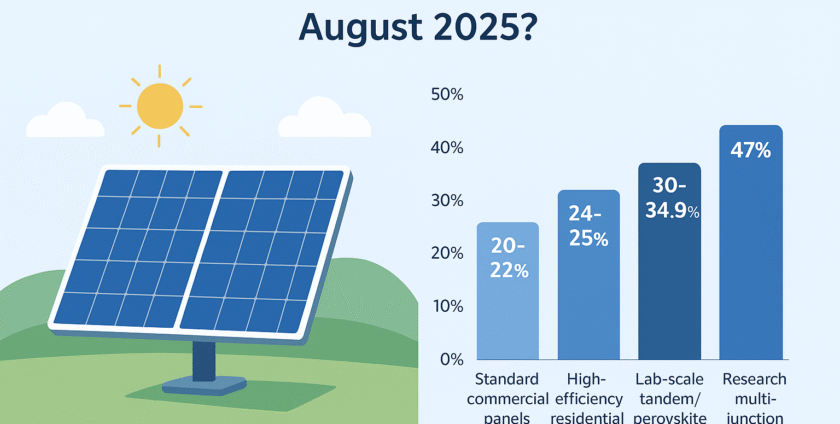
1. Current Performance of Commercial Solar Panels
In mid-2025, typical commercially available solar panels achieve efficiencies ranging from 20% to 22%, with many high-end models reaching 24–25% under standard test conditions (STC) EnergySage8MSolarClean Energy Reviews. Among technologies:
- Aiko Solar’s NEOSTAR 3P54 series leads residential markets with module efficiencies up to 24.8% Clean Energy Reviews.
- N-type TOPCon panels, from brands like Trina, Jinko, JA Solar, and Canadian Solar, commonly exceed 24% efficiency Clean Energy Reviews.
- Heterojunction (HJT) modules have hit about 25.44%, a record verified by Fraunhofer CalLab ReutersWikipedia.
2. Cutting-Edge Efficiency Advances
R&D continues to push boundaries:
- Lab records for commercial-scale solar cells now exceed 34%; theoretical conversion surpasses 30%, with performance up to 34.85% in tandem perovskite-silicon cells CouleenergyAccio.
- Perovskite tandem cells in labs have reached impressive efficiencies of 26.7%–33.9%, outperforming traditional silicon technology arXivWikipedia+1.
- Quantum dot enhancements, projected to double energy capture by utilizing broader light spectrums, are under development (e.g., UbiQD partnership with First Solar) Wall Street Journal.
3. Real-World Factors That Impact Efficiency
Efficiency in the lab doesn’t always translate to field performance—various environmental and design factors come into play:
- Temperature: Panel efficiency typically declines in higher ambient temperatures. Each panel’s temperature coefficient varies and influences performance pv magazine International.
- Soiling: Dust, pollen, and other deposits—or “soiling”—can dramatically reduce output. Losses of 1–2.5% per day have been documented, with extreme cases like 66% efficiency drop in heavily polluted areas Wikipedia.
- Bifacial designs: HJT cells also support bifacial modules, which capture reflected light from both sides—potentially improving yields by 10–30%, especially in reflective environments WikipediaAccioarXiv.
4. Technology Trends and Market Dynamics
- Perovskite solar cells: On their way to commercialization, they’re achieving >25% lab efficiencies. Tandems are pushing >30% in controlled settings AccioarXiv.
- Floating solar farms: Offer up to 15% performance gains via water cooling and reflection factors Accio.
- Building-Integrated PV (BIPV): Increasingly popular for seamless integration in architecture while still producing energy efficiently Accio.
Summary Table
| Category | Typical Efficiency (2025) |
|---|---|
| Standard Commercial Panels | 20–22% |
| High-Efficiency Residential (Aiko) | Up to 24.8% |
| N-type TOPCon & HJT (Commercial) | 24%–25.4% |
| Lab-scale Tandem/Perovskite Cells | 30–34.9% |
| Research Multi-Junction Cells | Up to ~47% under concentrated light |
Final Thoughts
As of August 2025, solar panels demonstrate strong efficiency at the commercial scale—24–25% is achievable for high-end modules. Laboratory breakthroughs—including perovskite tandems and quantum dot enhancements—are laying the groundwork for even higher efficiencies, potentially >30% in the near future.
But real-world gains hinge on environmental conditions, technology deployment, and innovative designs like bifacial modules and floating farms.
- By: IMH Technologies
- 0 comment

Leave a Reply